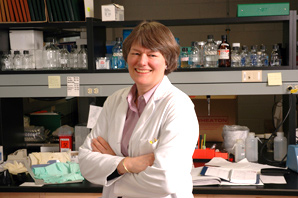Researchers at U of S VIDO-InterVac close in on vaccine to protect babies
Researchers at the University of Saskatchewan are closing in on a needle-free vaccine for respiratory syncytial virus (RSV), a major cause of respiratory illness in children under two years of age.
By Michael Robin Sylvia van den Hurk and her team have developed a vaccine candidate that shows promise against RSV, with human clinical trials about two years away.
Sylvia van den Hurk and her team have developed a vaccine candidate that shows promise against RSV, with human clinical trials about two years away."It's one of the most important respiratory infections in young babies. And there's no vaccine," van den Hurk says.
For most children, RSV infection means a runny nose, dry cough, sore throat, light fever and mild headache. In young infants, the virus can cause pneumonia or bronchiolitis, with a severe cough, high fever, and difficult breathing. Where children have access to good care, including respirators to deliver supplementary oxygen, the outlook is usually good. Where they don't, it's a problem.
"In developing countries and in the northern part of Canada, a lot more babies actually die," says van den Hurk, a professor of microbiology and immunology at the U of S College of Medicine and a research fellow at VIDO-InterVac (Vaccine and Infectious Disease Organization-International Vaccine Centre).
That may soon change. Van den Hurk and her team, including graduate students and postdoctoral fellows, have found that the vaccine candidate works in mice and cotton rats. The team recently received a $740,000 grant from the Canadian Institutes of Health Research (CIHR) to take the next steps.
The team delivers the vaccine through the nose, using a platform technology developed at VIDO-InterVac with funding from the Krembil Foundation and Bill and Melinda Gates Foundation.
"The challenge is to vaccinate while (maternal) antibodies are circulating, because these antibodies can inactivate the virus and prevent infection, but also inactivate the vaccine," van den Hurk says. "You have to formulate your vaccine to avoid that."
Baby's blood is full of mother's antibodies acquired during pregnancy and breastfeeding. These antibodies recognize the vaccine as a threat and eliminate it before the baby's own immune system can react. By avoiding the usual needle, the vaccine concentrates the immune response in the mucous membranes of the nose and lungs – exactly where the virus attacks – before maternal antibodies in the blood can deactivate the vaccine.
The vaccine candidate includes a protein from the surface of RSV. This protein is a molecular "lock pick" that allows the virus to gain entry into the cell, highjack its machinery, and establish an infection.
Since this protein is found on the surface of the virus, it's an ideal candidate to prime the immune system to create antibodies against it.
Delivering a vaccine to the mucous membrane poses challenges: enzymes can break it down, and the respiratory system itself is designed to sweep out foreign substances. To overcome this, van den Hurk and her team combined the protein with two adjuvants – substances that help activate the immune system. Then, they packaged it all in a particle designed to stick around long enough to spark an immune response.
The technology has been licensed to the Pan-Provincial Vaccine Enterprise Inc. (PREVENT), a National Centre of Excellence in Commercialization and Research, which is backing the technology through Phase 1 clinical trials. PREVENT conducts early stage clinical trials for promising vaccine candidates. This work is essential before vaccines can be commercialized.
Meanwhile, a focus of the CIHR grant is to unravel a mystery: when the vaccine formulation is put together, it works much better than any single ingredient alone.
"We find that when we put all these molecules together we get a synergistic effect, and we don't yet understand why," van den Hurk says. "With the new CIHR grant we will define the mechanisms responsible for this effect."
Part of this will be to look at how the RSV vaccine and its components function in the respiratory tract. The team will also study how various types of immune cells are activated and migrate toward the site of vaccination.
Understanding how the vaccine components work together will provide further support for testing this RSV vaccine in humans and allow researchers to capitalize on the technology in future vaccines against other important diseases.
U of S VIDO-InterVac is a centre of excellence for vaccine development and research, with eight commercialized vaccines, six of which were world firsts. For more information visit:
www.vido.org.

